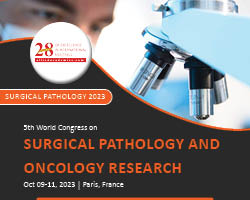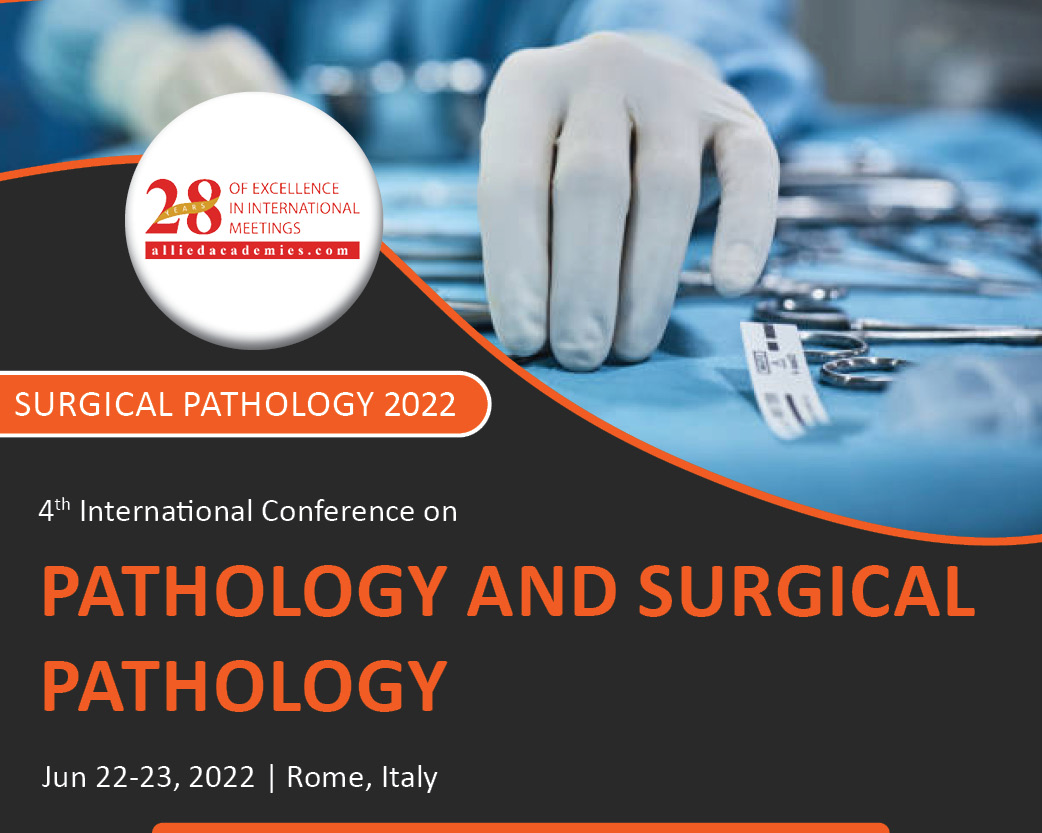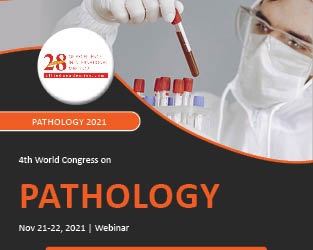2023 Conferences
2022 Conferences
2021 Conferences
In light of a legitimate concern for Allied Academies Conferences, we'repicturing an exquisite occasion with the superb analysts from completelydifferent countries and regions all over the world and sharing new andinnovative leads to Pathology.
All the Pathology conferencesactivity has been planned and enforced by the certification needs and policiesof the certification Committee and Organizing Committee. Pathology is the studyof the causes and effects of unwellness or injury. The word pathology additionally refersto the study of unwellness generally, incorporating a large variety of lifescience analysis fields and medical practices.
The analysis and study in knowing the suffering of apatient with distinction to its traditional perform are considerably outlinedas what Pathology illustrious in those classical days. Pathology stands as animportant field among all the fields of Medicine and holds its strong evidenceto interrelate with multiple fields of Biological Sciences. In gift, era Pathologystands as a serious branch in medication. Development of Pathology as a serioussubject has confronted a big attractiveness to fashionable medication andaugmentation of recent technologies in sickness diagnosing and medical aid.Today’s fashionable and potent techniques to review aspects of Anatomy andPhysiology have transgressed the definition of Pathology to any stage ofcrucial understanding of living organisms from Morphology to Anatomy, Anatomyto Organ Development, Organ development to Tissue transformation, Tissues toCellular development and from Cellular level to Physiological changes that seemthrough the impressive technology existing these days. Furthermore, the studyhas been evolved as Pathophysiology so with its large subjects of current trendit's been classified majorly into General and general Pathology.
The point of the Pathology conferences is to advance quality research and true effectin an air of genuine worldwide participation among researchers and scientistsby uniting again the world-class specialists, International Communities andIndustrial heads to examine the most recent improvements and developments inthe fields of pathological Science. This gathering will give a stage to thetrading of logical information and expert connections among pathologicalresearchers. Pathology Conferenceis cantered around General medical pathology, Dermatopathology,Forensic pathology, Cytopathology, Dermatopathology, Forensic pathology, Histopathology,Neuropathology, Pulmonary pathology, renal pathology, surgical pathology and so on.Our Conference wanted to remember with the best logical sessions, shows, blurbintroductions, oral introductions, workshops, symposiums, lunch, andextraordinary keynotes. Widely acclaimed speakers, the latest strategies,improvements and the most up to date refreshes in Animal Health, and Veterinaryare signs of our meeting.
Meet the eminent Speakers and specialists at the subsequent Pathology conference to debate on innovation and upgradation within the field of Pathological science and connected fields. The members will be profited with the paper proceeding in our Journal for free of cost, affirmation by our prominent committee individuals, e-Poster opportunity, etc. This is where every one of the Researchers, Scientists, pathology science experts, and diverse college faculties will examine pathological science and related development and upgradation just as they will impart their significant learning to other people.
Van Leeuwenhoek is credited with inventing the microscope, histological staining, and the earliest descriptions of spermatozoa, red blood cells, and giardia. John Hunter- Founded the pathology museum, which houses a unique collection of pathological specimens for the study of disease. Edward Jenner was the first to introduce smallpox vaccination. Xavi Bichat-Division of pathology research into general and systemic.
What is Pathology?
Pathos is the study of suffering as well as the study of disease's essential nature, disease process, and the structural and functional changes in organs and tissues that produce or are affected by disease.
The study of disease is known as pathology. It functions as a link between science and medicine. It supports every element of patient care, from diagnostic tests to treatment recommendations to the use of cutting-edge genetic technology and disease prevention. Pathologists are doctors and scientists who specialise in disease and illness.
The best pathologist of all time was Giovanni Morgagni (1682-1771), who flourished in the 18th century. His popularity grew beyond the borders of his native Italy, and he became regarded as the "Father of Modern Pathology."
Types of Pathology:
It is generally divided into 2 types
1. General pathology (eg.Common inflammation, cancer, ageing)
2. Systemic pathology (specific changes in organs eg. Goiter, pneumonia, breast cancer)
Sub classes:
Anatomical pathology
Clinical pathology
Molecular pathology
Anatomical Pathology: Anatomical pathology is a study that is concerned with the diagnosis of disease based on the microscopic, macroscopic, molecular, and immunologic and biochemical examination of organs and tissues. It also includes examination of the chemical properties of cells, and their immunological markers.
Clinical Pathology: It is a medical specialty that is concerned with diagnosis of disease based on laboratory analysis of bodily fluid such as blood and urine, using tools of chemistry, microbiology, haematology and molecular pathology.
Molecular Pathology: Molecular Pathology (MP) is at the guts of recent diagnostics and translational research, but the controversy on how MP is best developed has not abated. The lack of a correct model or trained pathologists to support the diagnostic and research missions makes MP a rare commodity overall. Here we analyse the scientific and technology areas, in research and diagnostics, which are encompassed by MP of solid tumours; we highlight the broad overlap of technologies and analytical capabilities in tissue research and diagnostics; and that we describe an integrated model that rationalizes technical know?how and pathology talent for both. The model is predicated on one, accredited laboratory providing one standard of high?quality for biomarker discovery, biomarker validation and molecular diagnostics.
Importance and Scope pathology:
Pathology is a medical specialty that is concerned with the diagnosis of disease based on the laboratory analysis of 11 bodily fluids such as, • Bile • Blood • Menstrual Fluid • Mucus • Pus • Semen • Saliva • Sweat • Tears • Urine • Vomitus Current trends: During this age of healthcare reform, pathology groups are confronted with a number of challenging pathology trends. One of the main trends is that, similar to clinical laboratories, many enterprises are in serious and perhaps unsustainable problems. Medical laboratories and pathology groups are likewise seeing significant changes in their clinical, nonsupervisory, and financial environments. Trends in pathology include
The importance of continuity of care is growing. • Directly integrating patient commerce with the lab association • Increasing interoperability expectations across a plethora of disparate information technology systems in order to achieve effective use • Cancer Research and Oncology Innovations • Vaccines to Prevent Cancer • Immunology in Cancer • Oncology Translation • Cancer rectifiers with a holistic approach • TGF-Blocking Turns Cold Tumours into Hot Tumours • Nano informatics Transforms Personalized Cancer Treatment • Cancer Inauguration and Epigenetic Priming • Oncology clinical trials. The COVID-19 Epidemic's Impact on the Digital Pathology Market- The COVID-19 epidemic is expected to have a beneficial influence on global digital pathology demand. The US FDA's Centre for Bias and Radiological Health published an enforcement policy for remote digital pathology bias, which is aimed at pathologists, clinical laboratories, and medicine administration workers. As a result of the increase in cases of habitual conditions, the operation of digital pathology systems for opinion has grown, which is expected to drive digital pathology requests during the casting period. As a result, new inventions by key players and an increase in the number of product benefits drive demand growth. Nonetheless, the expensive cost of digital pathology systems is expected to limit demand development during the decade.
Major industries:
- Danaher
- Hamamatsu Photonics, Inc
- Koninklijke PhilipsN.V.
- Olympus Corporation
- Hoffmann-La Roche Ltd
- Mikroscan Technologies
- Inspirata, Inc
- Visiopharm A/ S
- Huron Digital Pathology
- 3DHISTECH Ltd
Pathology Societies and Associations
Pathology Conference | Pathology Conferences | Clinical Pathology Conference | Anatomical Pathology Conference | Digital pathology Conference | Neuropathology Conference | Histopathology Conference | Molecular Biology Conference | Microbiology Conference | Immunology Conference | Pathology Events | Pathology Meetings | Pathology Gathering
- Asian Society for Clinical Pathology and Laboratory Medicine -ASCPaLM-Japan
- Asian Association of Societies for Plant Pathology -AASPP-Indonesia
- Sociedad Latinoamericana de Patología Pediatrica -SLAPPE-Unknown
- Asociación Latinoamericana de Patología Clínica -ALAPAC/ML-Bolivia
- International Academy of Pathology -IAP-Canada
- International Society for Animal Clinical Pathology -ISACP-Netherlands
- International Society for Pathophysiology -ISP-China-P.R.
- Sociedad Latinoamericana de Patologia -SLAP-Panama
- World Association of Societies of Pathology and Laboratory Medicine -WASPaLM-Japan
- European Association for Potato Research Pathology SectionFinland
- Am Phytopathological & Entomological Soc- Joint Mtg
- Society for Invertebrate Pathology -SIP-U.S.A.
- International Conferences for Rare Diseases and Orphan Drugs -ICORD- Sweden
- European Helicobacter Study Group -EHSG-France
- American Society for Microbiology -ASM-USA
- International Union of Microbiological Societies -IUMS-Netherlands
- International Commission on Yeasts -ICY- of the International Union of Microbiological Societies -IUMS-Ukraine
- Nordic Society for Medical Mycolology -NSMM-Finland
- Small Meeting on Yeast Transport and Energetics-SMYTE-Mexico
- Federation of European Microbiological Societies -FEMS-Netherlands
- Asia Pacific Division of the International Academy of PathologistsHong Kong, China-P.R.
- International Association of Sexual Plant Reproduction Research -IASPRR-United Kingdom
- KANSAS STATE UNIVERSITY AGRONOMY DEPARTMENT
- American Heartworm Society
- Federation of European Microbiological Societies
- International Federation of Nematology Societies
- American Society of Agronomy
- Canadian Society of Agronomy = Société Canadienne d'Agronomie
- European Society for Agronomy
- Swiss Society of Aerobiology
- American Head and Neck Society (AHNS)
- American College of Phlebology
- National Foundation for Infectious Diseases
- National Institute of Allergy and Infectious Diseases
- American Thoracic Society (ATS)
- International Society for the Study of Personality Disorders (ISSPD)
- Advisory Committee on Dangerous Pathogens The
- Medical Association of Thailand
- Hypnotherapy Association
- ASEAN Neurological Association
- Australian Association of Neurologists
- British Neuroscience Association
- Virginia Veterinary Medical Association
- West Virginia Veterinary Medical Association
- Wisconsin Veterinary Medical Association
- American Society for Investigative Pathology (ASIP)
- American Pathology Foundation (APF)
- American Society for Clinical Pathology (ASCP)
- American Society for Investigative Pathology
- American Society for Investigative Pathology (ASIP)
- American Society of Clinical Pathology (ASCP)
- American Society of Cytopathology
- American Society of Cytopathology (ASC)
- Analytical Cellular Pathology (ACP)
- Armed Forces Institute of Pathology The (AFIP)
- Asia Pacific Pathology - APP
- Asian Association of Societies for Plant Pathology
Market Analysis:
The global digital pathology market was worth $735.75 million in 2020, and is predicted to grow to $1791.30 million by 2030, with a CAGR of 9.3% between 2021 and 2030. Digital pathology is a computer-assisted, image-based information platform that aids in the administration of digital slide data. In two ways, digital pathology technology can help a research pipeline. The first is that macroscopic photographs, tissue microarrays, and full slide images can all be arranged using the stated file storage and viewing software. The creation and deployment of image analysis techniques is the second use of digital pathology in research.
The rise in the demand for accurate diagnostics, as well as the development of innovative digital pathology systems by a wide number of important companies, are driving the global digital pathology market forward.
The COVID-19 epidemic is expected to have a beneficial impact on the worldwide digital pathology industry, fueling its expansion. The US Food and Drug Administration's Center for Devices and Radiological Health issued an enforcement policy for remote digital pathology devices, which are meant for pathologists, clinical laboratories, and drug administration personnel. As a result, the rising use of digital pathology systems for diagnosis has increased, which is expected to drive the digital pathology market throughout the forecast period.
The market for digital pathology is divided into four categories: type, application, end user, and geography. The market is divided into three types: scanners, software, and storage and communication systems.
Teleconsultation, disease diagnosis, drug research, and training & education are the different types of applications. It is divided into educational, clinical, and pharma & biotech enterprises based on the end user.
The market is divided into four regions: North America (the United States, Canada, and Mexico), Europe (Germany, France, the United Kingdom, Italy, Spain, and the rest of Europe), Asia-Pacific (Japan, China, Australia, India, South Korea, and the rest of Asia-Pacific), and LAMEA (Latin America, Middle East, and Africa) (Brazil, Saudi Arabia, South Africa, and rest of LAMEA).


